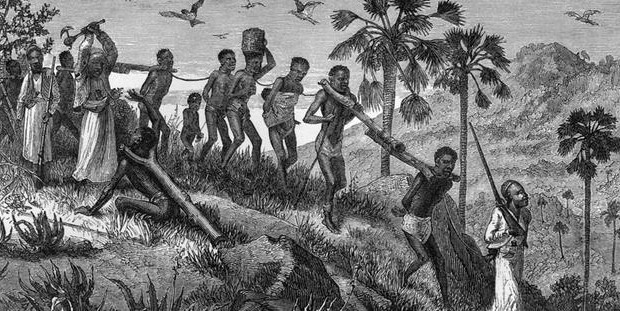By Thomas Hauschildt, Senior Fellow
23rd August 2014, Human Rights and Conflict Resolution
Today is the ‘International Day for the Remembrance of the Slave Trade and Its Abolition’.
This week the international society remembers the slave trade and its abolition. However, with an estimated 20-30 million victims subject to modern-slavery, this crime is still all too present in our societies.
Whether it is men forced into labour to build the stadiums for the 2022 football world cup in Qatar, child labourers on cocoa farms in West Africa, child soldiers in Central Africa, women enslaved in US households, men and women subject to bondaged labour in India, victims enforced to work on fishing boats in Thailand, or wome forced into marriage and a life of servitude in Europe and elsewhere, modern slavery is a global problem still prevelant in many parts of our society.
The International Labour Organizination reported that forced labour generates a profit of US $150 billion in the private sector alone. Although the underlying factors might vary from region to region, slaves worldwide are often subject to the same egregious treatment, including forced labour, physical and mental abuse, the threat of violence and restrictions on the freedom of movement.
Many are subject to human trafficking and are treated as “commodities” that can be bought or sold.
Although, international conventions and declarations, such as the Universal Declaration of Human Rights (UDHR) adopted in 1948, outlaw slavery an estimated 20-30 million people worldwide are subject to slavery.
Countries with the highest prevelance of slavery are Mauritania, Haiti, Pakistan, India and Nepal. Mauritania was the last nation to ablish slavery in 1981 and until 2007 it was not even a crime to hold slaves. The Walk-Free Foundation estimates that four percent of the country’s population is still enslaved whilst SOS Slavery estimates the number to be as high as twenty percent.
Nearly half of the people forced into slavery live in India. Debt bondage, often passed onto the forthcoming generations, is common and in some cases children become chattels the moment they are born. Although the country’s large population needs to be taken into conisderation when looking at total numbers, it is clear that increased efforts in India could result in halving the number of slaves world wide.
Nonetheless, even better developed countries need to do more to tackle slavery. Political stability, minority rights, the rule of law and a high ranking on the development index are all essential factors to fight slavery. However, they are no guarantes for the absence of slavery and it is believed that in the developed economies alone 1.5 million people are subject to slavery.
The UK, together with Ireland and Iceland, is estimated to have the lowest prevalence of slavery. Nonetheless, current estimates about the number of slaves in the UK range from 5,000 to 20,000. In a recent case, eight man were rescued after being forced to work on a farm.
In order to fight slavery, the UK Government hopes to adopt the Modern-Slavery Bill before the next general election. The Bill – the first of its kind in Europe – is accompanied by a TV campaign titled ‘Slavery is closer than you think’, emphasising the plight of victims who have been forced into domestic servitude, prostitution and agricultural labour. The aim is not only to raise awareness of slavery happening in the midst of our society, but also to encourage the public to report cases of suspected slavery.
In order to tackle slavery we need to address root causes and symptoms alike. Law enforcement needs to be accompanied by socio-economic measures and national legislation to hold offenders accountable. Raising awarness, as the UK Government is doing in its campaign, is a step in the right direction.
However, we not only have to be aware of slavery in our own society, but also of products likely to be produced by modern slaves. Cocoa products are a case in point. Dutch Journalist Teun van de Keuken has raised public awareness of child labour and slavery on cocoa farms by handing himself into police for accomplicancy in slavery as a chocolate consumer. He was not tried, but set up his own slave-free chocolate company.
Customers are also stakeholders of the supply chain and can therefore be implicit in modern-slavery. In fact, customers are the most important stakeholders as their choices determine which products are being bought. Moreover, companies need to ensure that every step of the supply chain is free from slave labour. Products could then be labelled accordingly to allow customers to make well informed choices.
Finally, we need more cultural awarness, especially in countries such as Mauritania. Legislation can play its part, but only when people are educated about the rights of every individual, is change for the better more likely to happen. Moreover, poverty is a strong incubator for slavery. If we fight poverty, we reduce the likelihood of men, women and children becoming the victims of slave traders.
It is therefore up to all of us to contribute whatever we can to combat modern slavery. Only then, slavery can be truly a thing of the past.
This article was published at Left Foot Forward.
Thomas Hauschildt is contactable at: thomas.hauschildt@hscentre.org
Cite this article as: Hauschildt, T. (2014). ‘Did we ever really abolish salve trade?’ Human Security Centre, Human Rights and Conflict Resolution
 Human Security Centre Human Rights and International Security Research
Human Security Centre Human Rights and International Security Research




